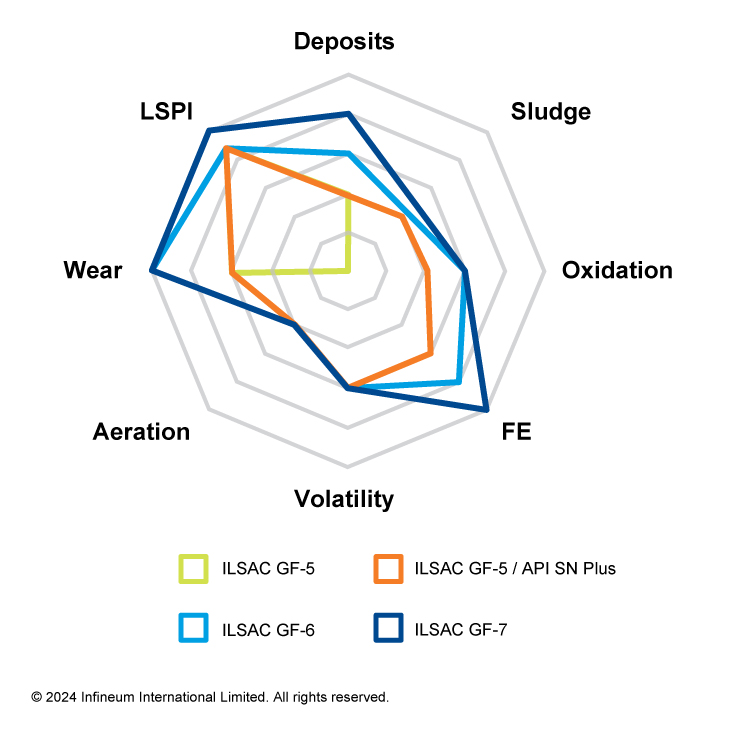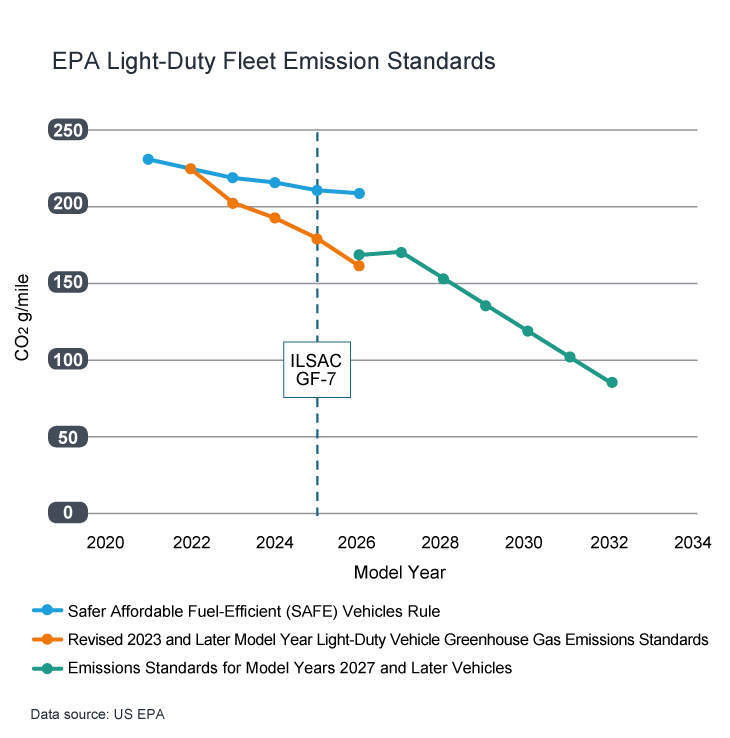ILSAC Categories
ILSAC GF-7 ready
08 April 2025
05 November 2024
Key drivers and changes in the new engine oil category

Increasingly stringent emissions and fuel economy legislation are driving changes to passenger car hardware system design and engine operating conditions. Eugene Ong, Infineum Sustainability Transportation PCMO Product Manager, explains how these factors put a higher performance load on the lubricant and are the key drivers for the introduction of the new ILSAC GF-7 engine oil category.
Following a period of negotiation and compromise, the needs and targets set out by ILSAC for ILSAC GF-7 were finally approved with a first allowable use (FAU) date of 31 March 2025. This gives oil marketers the mandatory 12 month waiting period to get products developed, tested and into the market. So just why is ILSAC GF-7 needed, what is it designed to do, what are the key changes vs. ILSAC GF-6? Read on to find out.
OEMs have been working to produce cleaner, more fuel efficient internal combustion engine platforms to meet regulated fuel economy/CO2 emissions targets. At the same time car drivers expect improved vehicle performance and reliability. To meet these challenges, OEMs continue to introduce new hardware and vehicle control systems for example, engine downsizing with direct injection, increased turbocharging, friction reduction, along with advancements in aftertreatment and combustion technology.
All these changes rely on the ability of higher quality engine oils to deliver sufficient engine and aftertreatment protection and prevent operational issues, while contributing towards improving fuel economy - particularly through the use of lighter viscosity grades. This creates new lubricant performance challenges, and ILSAC GF-7 sets the standards to meet them.
ILSAC GF-7 defines a new and improved performance level of engine oils for spark-ignited internal combustion engines.
The key objectives of ILSAC GF-7 are to:
The chart below summarises the increase in performance needs from ILSAC GF-5 through to ILSAC GF-7.

In April 2020, the National Highway Traffic Safety Administration (NHTSA) and US Environmental Protection Agency (EPA) amended the Corporate Average Fuel Economy (CAFE) and greenhouse gas (GHG) emissions standards for passenger cars and light trucks. A new Safer Affordable Fuel Efficient (SAFE) vehicles rule has been established that increases the stringency of CO2 emissions for model years (MY) 2021 through 2026.
To address this, Sequence VIE and VIF in ILSAC GF-7 call for an increased stringency of fuel savings properties over time. This helps provide an increased contribution to the current fuel efficient engines, supporting OEMs’ goals of meeting these new regulations as we push for further CO2 emission reduction by transitioning to a thinner viscosity grades such as SAE 0W-20 or SAE 0W-16.
As we move to these lower viscosity grades, it is increasingly important to control deposits.
In addition, keeping engines clean is a good way to improve combustion efficiency and thus reduce CO2 emissions. This is supported by the higher piston cleanliness ratings in the Sequence IIIH test.
Another OEM tactic to reduce fuel consumption, while maintaining torque and power, is to reduce engine displacement and make up the difference in power by turbocharging. However, these downsized and boosted engines can exhibit a destructive abnormal combustion event called low-speed pre-ignition (LSPI). This phenomenon occurs prior to the spark being triggered and is often followed by heavy knock that can lead to severe engine damage.
Concerns had been expressed that the fresh oil LSPI test, introduced in ILSAC GF-6, may not maintain protection over the full oil drain interval. To improve LSPI protection, ILSAC GF-7 introduces an aged version of the LSPI test with the same limit as the Sequence IX test.
ILSAC GF-7 also includes improvement to wear protection via a slight reduction to the maximum limit in the chain wear.
The key changes between ILSAC GF-6 and ILSAC GF-7 are summarised below:

In addition to existing phosphorus and sulphur limitations, a new requirement restricts sulphated ash (SASH) to 0.9% mass. This is designed to support the introduction of aftertreatment devices, such as gasoline particulate filters (GPF), that will be needed to meet emissions regulations. Other changes include a new fresh oil MRV limit of 40,000 cP (33% change vs. ILSAC GF-6) plus elastomer compatibility with new seal materials and the possible introduction of new gelation test, if available at first licensing.
Delivering both the improved fuel economy performance and hardware protection requires advanced componentry and a careful formulation balance.
Infineum is ILSAC GF-7 ready in our mainline and top-tier product portfolios, with the key objective of simplifying complexity without compromising on performance.
Having initially designed two of our platforms to surpass all ILSAC GF-6 requirements, these proven products are now ILSAC GF-7 ready. Customers who have purchased these technologies are already enjoying these ILSAC GF-7 capable products on the road today* - and have a seamless transition through this accelerated category.
The EPA reports that the transportation sector is the largest US source of GHG emissions, representing 29% of total GHG emissions. Within the transportation sector, light-duty vehicles are the largest contributor, at 58%. The organisation says that continued GHG emission reductions in the motor vehicle sector are needed to protect public health and welfare.
In March 2024, EPA announced new, more protective final standards to further reduce harmful air pollutant emissions from light-duty and medium-duty vehicles starting with MY 2027.

ILSAC GF-7 is, in our view, an interim transition to ILSAC GF-8. With this in mind, we will keep you up to date on developments, which are likely to be timed with the increasing severity of EPA CO2 emissions regulations for MY 2027 through 2032.
By developing products with wide viscosity grade and base stock coverage we will provide customers with a seamless interim transfer to ILSAC GF-8.
*Please do not hesitate to reach out to your relevant Infineum representative to understand more details about your existing technologies, their current capabilities and how we can address your coverage needs.
Sign up to receive monthly updates via email